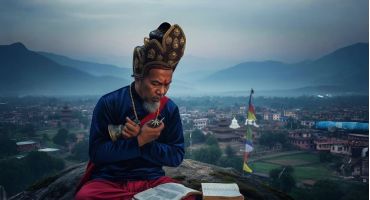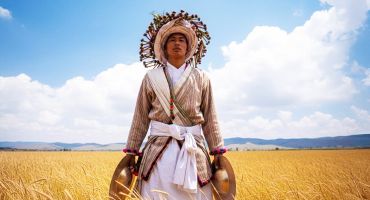Sunuwar people, also known as Mukhia, are one of the four branches of the Kirati tribe. The term Sunuwar was used because they lived on the banks of the Sunkoshi River, while Mukhia is an Indo-Aryan term conferred upon by the Sen Kings. Today, they prefer to call themselves Koĩts in their mother tongue and are proud to identify themselves as Kirati-Koĩts. Kirati Koĩts follow the Mukdum which is equivalent to the Mundhum followed by Khambus and Limbus. While the Khambus lived in “Majh Kirat” and the Limbus in “Pallo Kirat”, the Kirati Koĩt people inhabited the Wallo Kirat Region that falls between the Sunkoshi and the Dudh Koshi Rivers. Their language called Koĩts Lo is about 90% similar to the language of the Bahing/Bayung Rai people.
********************************
The Sunuwar cultural backdrop is highly imbued with ritual motifs, not just through traditions handed over by the ancestors, but by the perceived occupation of indiscernible entities, such as nature and ancestral spirits. Even as cultures have intermingled, traditions expanded, contemporary Sunuwar people use Shamanic knowledge to help them make sense of events occurring in their environment. Within the conceptual structure of memory and space predicated by Sunuwar Koĩts culture, the shaman transforms it into a reality by ritually influencing the transcendent forces perceived as the basis of cause and effect.
Among the systematic ceremonies occurring amid Sunuwar cultural domain, rituals are certainly the ones that hold great prominence and significance. The sociological approach to observing Sunuwar Koits traditions is primarily through a functional analysis of their rituals –domestic and public. These rituals and other cultural traditions help contribute to the survival of the society by promoting social integration and interaction.
Sunuwar traditions employ two different types of officiants for their rituals. There is a Naso/Nokso who is a performer of rituals and a Poinbo or Ngyami, who are shamans. A male shaman is known as Poinbo, and a female shaman is called Ngyami. A Naso isn’t a traditional shaman and is not capable of making a two-way communication between the spirit world and the human realm. However, he holds vast knowledge of the Koĩts Mukdum/Mundhum (ritual language, oral narrative) and performs rituals and invokes the ancestral spirits of respective Sunuwar lineage. This ritual language is also known as Salak or Salaku and intonated by both types of officiants. He can perform sacrificial rites and all traditional rituals.

Naso is a hereditary position and acquired by male offspring for a particular lineage. It is usually a father Naso, who grooms his son to take over the responsibility of rituals. The son has to memorize all ritual chants by a repetition of ritual procedures and through observation. This training and familiarization begin at a very young age. He will be required to learn about the oral traditions of the tribe and all the myths of his culture, from the elders. At the death of his father, it is he who has to carry out funerary rites.
Sunuwar people have developed coherent ritual classifications that originate with belief systems and creation myths, transmitted orally from one generation to the next. It is a Naso who performs these rituals in the community. He conducts all life-cycle rituals and public worship events like Syadar (Nature Worship) and Surom (Worship for prosperity). His main performance is the ancestor worship ritual called Chegu in which Yabre Gubre, the dead ancestral spirits are worshipped. The performance of the Sunuwar rituals serves to infuse, validate, and maintain the values of their traditions. It is a Naso who upholds these traditions through rituals.
In contrast, the position of the Poinbo or Ngyami is never hereditary. They are traditional shamans and only those who have been approached by the spirits through dreams and visions can become a Poinbo or Ngyami. These spirits, over time, impart wisdom and power to them.

Much like the Naso, shamans also undergo a period of training when they learn how to cultivate and interpret dreams and visions from an experienced shaman who will become their spiritual mentor. While the Naso operates and performs sacrificial rites during the daytime, the Poinbo or Ngyami perform their rites at night to reduce awareness of the surroundings outside his/her focus. It is also generally disclosed by shamans that they can see spirits better at night.
Poinbo or Ngyami usually perform séance and exorcise ghosts and evil spirits from the living. Their practice includes spiritual healing and appeasing or banishing wandering souls of those who have died an unnatural death. They are psychopomps who act as arbitrators between evil spirits and living, and their sphere of ritual practice is not limited to only the Sunuwar Koits. They are also employed by other communities for rites during ‘inauspicious’ events.

Naso and Poinbo/ Ngyami wear different costumes, utilize different percussive instruments and items of spiritual defense. A Naso uses his bow and arrow, one passed on by his father, while the Poinbo/ Ngyami use a wooden knife called Phurba. While both enjoy dissimilar powers and authority and have distinct individual journeys, during public rituals the Naso requires the help of the Puimbo or Ngiami to invoke and summon the spirits for whom the rite performed. When the ceremony is over, they also need to help the spirits return to the spirit realm.
For the Sunuwars who are spiritually pluralistic, rituals reflect and construct social, political, ethnic, and economic relationships. They represent the very center of the community, where sacred traditions and their cultural contexts become exceedingly significant. Sunuwar Koĩts liturgical traditions uncover the interwoven complexity marked by overlapping identities of tribe, ethnicity, and region. But these officiants simplify them by clearly demarcating and maintaining a great degree of distinctiveness. Sunuwar officiants are all connected and aligned for both are employed in the service of the community, and work within the sphere of ritual contexts.





Leave a Reply